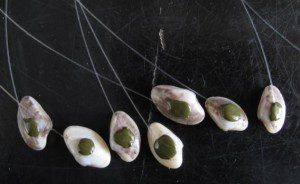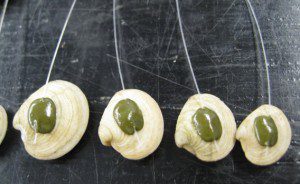Tanya Rogers FSU Coastal & Marine Lab
 It’s a problem commonly faced by field biologists: You want to put some particular critters out in the field in various places, but how do you keep them from getting swept away or wandering off too far, and how do you ever find them again later to see how they did? Behold the tether! So long as tethers are designed not to interfere too much with the animals’ natural behavior (walking around, burrowing, etc), leashing them to a fixed object is generally a good way to relocate them (provided you study something like crabs or snails and not lions or bald eagles). The other fun benefit of tethering marine invertebrates: you can take them for walks (albeit slow ones).
It’s a problem commonly faced by field biologists: You want to put some particular critters out in the field in various places, but how do you keep them from getting swept away or wandering off too far, and how do you ever find them again later to see how they did? Behold the tether! So long as tethers are designed not to interfere too much with the animals’ natural behavior (walking around, burrowing, etc), leashing them to a fixed object is generally a good way to relocate them (provided you study something like crabs or snails and not lions or bald eagles). The other fun benefit of tethering marine invertebrates: you can take them for walks (albeit slow ones).
 I recently conducted an experiment in which I put tethered baby clams (sunray venus and quahog, about 12 mm long) out on Bay Mouth Bar to see how their growth, survivorship, and burial depth was affected by (1) their location on the bar (NE, SW, SE, NW) and (2) the type of habitat the clams were in (sand, shoal grass, turtle grass). I checked on the clams a month later: some were still alive and growing, others were dead with clues indicating their likely cause of demise – gaping shell with no damage (stress), cracked shell (eaten by crab), drill hole in shell (eaten by predatory snail). My preliminary analysis suggests that survivorship and causes of death varied between habitat types. Next I hope to do a similar sort of study with tethered snails on Bay Mouth Bar.
I recently conducted an experiment in which I put tethered baby clams (sunray venus and quahog, about 12 mm long) out on Bay Mouth Bar to see how their growth, survivorship, and burial depth was affected by (1) their location on the bar (NE, SW, SE, NW) and (2) the type of habitat the clams were in (sand, shoal grass, turtle grass). I checked on the clams a month later: some were still alive and growing, others were dead with clues indicating their likely cause of demise – gaping shell with no damage (stress), cracked shell (eaten by crab), drill hole in shell (eaten by predatory snail). My preliminary analysis suggests that survivorship and causes of death varied between habitat types. Next I hope to do a similar sort of study with tethered snails on Bay Mouth Bar.
We want to hear from you! Add your question or comment.
In the Grass, On the Reef is funded by the National Science Foundation.

